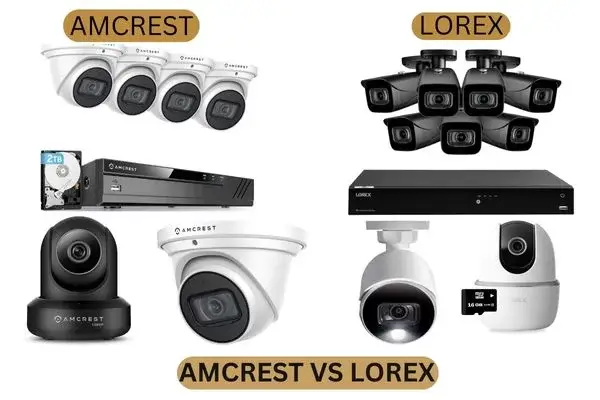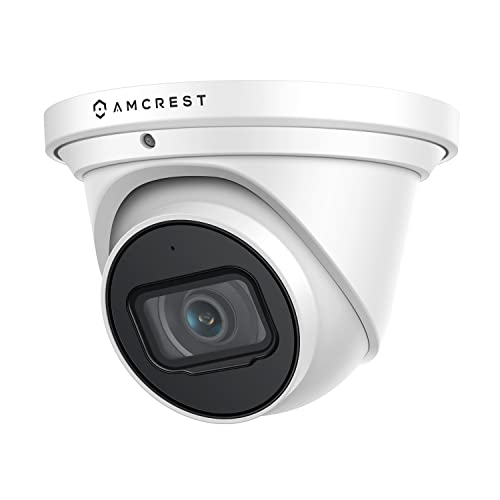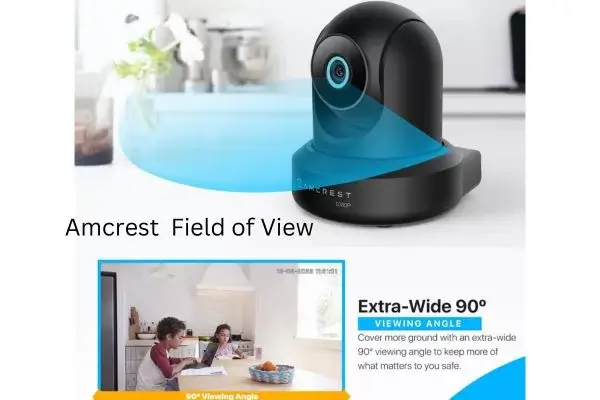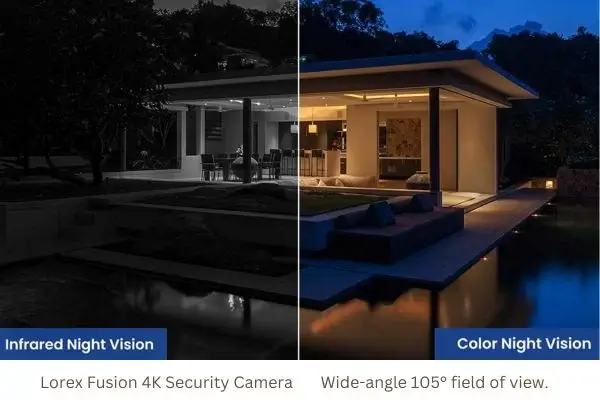Amcrest and Lorex are both popular brands in the home and business security camera market, known for offering a wide range of surveillance products. The choice between the two ultimately depends on your specific needs and preferences.

Table of Contents
ToggleAmcrest vs Lorex Comparision
Here are some factors to consider when comparing Amcrest and Lorex:
Camera Quality and Resolution:
Both brands offer cameras with various resolutions, including 720p, 1080p, 2K, and 4K. Consider the level of detail you require for your surveillance needs.
Camera Types:
Both brands provide a variety of camera types, such as dome, bullet, PTZ (pan-tilt-zoom), and more. Choose the camera type that suits your installation location and requirements.
Price Range:
Amcrest tends to be more budget-friendly compared to Lorex but this can vary depending on specific models and features.
Price Amcrest



Last update on 2024-07-21 / Affiliate links / Images from Amazon Product Advertising API
Price Lorex



Last update on 2024-07-21 / Affiliate links / Images from Amazon Product Advertising API
Ease of Installation:
Evaluate the ease of installation for both brands. Some customers prefer wireless cameras for simpler setups, while others opt for wired cameras for added reliability.
Video Storage:
Both brands offer different options for video storage, including local storage (NVRs or DVRs) and cloud storage. Consider your preferences and budget for storage solutions.
Mobile App and Remote Access:
Check the user-friendliness and features of the mobile apps provided by each brand for remote access and monitoring.
Night Vision:
Assess the night vision capabilities of the cameras, as this is essential for around-the-clock surveillance.
Motion Detection and Alerts:
Consider the motion detection capabilities and the ability to receive alerts on your mobile device when activity is detected.
Integration with Other Smart Devices:
Determine if the cameras are compatible with other smart home devices and platforms, such as Alexa or Google Assistant.
Safeguard Your Loved Ones with Amcrest vs Lorex. Get the Best Security Solution.
1. Camera Lens Specs
Amcrest provides a broad selection of models, each catering to various needs. Their cameras come with focal lengths ranging from 1.4mm to 4mm, ensuring comprehensive coverage of the monitored area. The majority of Amcrest models feature a fixed-focus lens, which maintains constant focus and sharp image quality. Some models also offer motorized lenses for zooming capabilities. Additionally, Amcrest cameras offer a resolution spectrum from 2MP to 12MP, allowing you to choose the right level of detail for your specific requirements.
2. Field of View
Amcrest offers an extensive range of field-of-view options. Their cameras provide horizontal fields of view ranging from 90 degrees to 180 degrees. This flexibility enables you to select a solution tailored to monitoring narrow alleys or spacious rooms without compromise. Moreover, Amcrest’s image sensors come in sizes ranging from 1/3″ to 1/1.7″, ensuring impressive image quality, especially in low-light conditions.

Lorex, too, offers a diverse selection of security camera models. With focal lengths spanning from 2.6mm to 5.3mm and both fixed focus and motorized lens options, Lorex cameras excel in addressing various surveillance needs. Their camera resolutions are also competitive, with models ranging from 2MP to 8MP.
Lorex cameras feature horizontal fields of view starting at approximately 54 degrees and going up to 164 degrees, providing a range of coverage suitable for different surveillance scenarios. Their image sensor sizes are predominantly 1/2.8″ or 1/3″, ensuring image clarity in varying lighting conditions.
3. Night Vision
Amcrest offers a diverse selection of camera models with various night vision capabilities. The majority of these models employ infrared (IR) and full-color technology through a low-light sensor. Some models, such as the IP8M-TB2886EW-AI, IP8M-2496EW-V2, and A5TN28-W, also feature spotlights to improve visibility in dark scenarios. The infrared distance for Amcrest cameras typically ranges between 32 feet and 328 feet, providing extensive coverage during nighttime hours.
Lorex cameras also come equipped with diverse night vision capabilities, including infrared, full-color technology via a low-light sensor, and full-color via a spotlight. Models like the W881AAD-E, W452ASDB-E, V261LCD-E, and U471AA-E even boast Active Deterrence Technology, which enhances security by discouraging intruders from attempting any breach. The infrared coverage for Lorex cameras spans from 27 feet up to 300 feet, depending on the model.

4. Minimum Illumination for Color
The minimum illumination for color is a crucial factor to consider, as a lower value suggests improved functionality in low-light situations. Throughout the Amcrest range, minimum illumination values range from 0.005 to 0.0840. In contrast, Lorex models typically have minimum illumination values ranging between 0.005 and 0.02. In most scenarios, Amcrest offers superior low-light color visibility.
5. Infrared LEDs
When it comes to the number of infrared LEDs, both Amcrest and Lorex cameras offer varying options. Some models have as few as 1 LED, while others boast up to 12 LEDs. The presence of more Infrared LEDs generally results in better visibility during nighttime hours.
6. Camera Smarts
In terms of smart integrations, Lorex appears to offer more options, supporting Alexa, Google Assistant, Chromecast, Fire TV, and Apple TV for select models. Amcrest supports Alexa for some models but does not currently offer Google Assistant or Chromecast support. If you prefer a security camera system that seamlessly integrates with your existing smart home ecosystem, Lorex may have the advantage.
7. Motion Detection
Motion detection features are vital for effective home security. Both Amcrest and Lorex offer configurable motion zones and motion sensitivity in many of their models. This allows users to focus the camera’s attention on specific areas while reducing false alarms. Additionally, both brands provide motion alerts, with push notifications being the most common method.
When it comes to advanced detection features, Amcrest has a wide variety of options across its models, including person detection, vehicle detection, face detection, heat maps, and people counting. On the other hand, Lorex offers person detection, vehicle detection, animal detection, and object detection in some of its models.
8. Advanced Features
Perimeter protection features in security cameras add an extra layer of security to your property. Amcrest offers robust perimeter protection options, including tripwire detection and intrusion detection in many models, with additional features like crowd gathering detection and region entrance/exit detection available in select models. Lorex, however, appears to have fewer models with these advanced features.
Finally, both Amcrest and Lorex provide other event triggers in some of their models. Amcrest models may include triggers such as abandoned objects, missing objects, video tampering, and storage anomalies. Lorex offers similar triggers like abandoned objects, missing objects, and video tampering in some models.
9. Audio & Alarms
The majority of both Amcrest and Lorex security cameras offer integrated microphones, enabling them to deliver clear audio alongside video footage. This feature is particularly useful in scenarios where capturing audio alongside video is important for security purposes.
Regarding alarm systems, external alarm interfaces appear to be more common in Amcrest cameras compared to Lorex models. These interfaces allow your camera to connect with other security devices, creating a centralized security system that streamlines monitoring and control efforts. Some Amcrest cameras are equipped with sirens, while many Lorex models have built-in sirens as well, providing an additional layer of security.
Two-way audio is another noteworthy feature available in many Amcrest and Lorex models, allowing you to listen and talk through the camera. This enhances communication with individuals on your property and can potentially deter intruders.
10. Camera Storage
Amcrest cameras tend to have onboard storage capacities ranging from 128GB to 512GB, with most models supporting 256GB microSD cards for local storage. Additionally, Amcrest cameras are compatible with storage options like Network Video Recorders (NVR), Network Attached Storage (NAS), File Transfer Protocol (FTP), and Cloud. Some Amcrest models require a Digital Video Recorder (DVR) for storage.
On the other hand, Lorex cameras offer onboard storage capacities of 256GB, available with certain models. Lorex’s storage options include microSD cards, NVR, DVR, NAS, FTP, and Wireless Hubs, with specific devices limited to particular storage means. While some Lorex cameras officially support fewer interoperability options than Amcrest, select models are compatible with ONVIF, RTSP, and CGI.
11. Camera Build Quality
Amcrest cameras are constructed using various materials, including metal, heavy-duty metal, aluminum, and plastic. These materials contribute to their durability and suitability for different environments. Most Amcrest models offer high IP ratings, such as IP67 and IP66, ensuring they can withstand harsh weather conditions. Additionally, Amcrest provides models designed specifically for indoor use, featuring plastic construction and weather-resistant ratings for indoor security options.
Similarly, Lorex cameras are built using materials such as metal, heavy-duty metal, aluminum alloy, and polycarbonate, ensuring strength and durability across their product lineup. Lorex offers models with high IP ratings (IP66 and IP67) for weather resistance, as well as a few models with lower IP ratings, like IP65. Lorex cameras also feature impressive temperature resistance, with some models capable of operating within -40°F to 158°F (-40°C to 70°C), making them suitable for extreme weather conditions.
When it comes to camera weights, both Amcrest and Lorex offer a range of lightweight and heavy-duty options. Amcrest camera weights vary from 240g to 4,699g, with heavier cameras typically featuring more advanced features and higher durability. Lighter cameras may be easier to install and are often more suitable for indoor use.
Lorex cameras, on the other hand, come in weights ranging from 190g to 5,300g, providing flexibility in selecting the right camera for your specific needs. Heavy-duty Lorex cameras are designed to withstand harsh conditions, while lighter models offer versatility for various installations.
Maximum operating humidity is another consideration when evaluating camera build quality. Amcrest cameras generally operate at humidity levels of around 95%, ensuring they can handle high levels of moisture in the environment. Lorex cameras have a slightly lower operating humidity, ranging from 90% to 98%, which still allows them to function effectively in humid conditions.
13. Video Streaming
Amcrest and Lorex cameras both support multiple video streams, with Amcrest cameras typically offering support for up to three streams. This feature enables different users to access the camera simultaneously with separate settings, allowing for versatile monitoring and sharing of footage.
Privacy masking is another essential feature provided by both Amcrest and Lorex in select models. Privacy masking allows you to obscure specific areas within the camera’s field of view to protect personal privacy or sensitive information. While Amcrest models often include privacy masking as a standard feature, Lorex offers it in some of their models as well, ensuring user privacy is a top priority.
14. Power & Data Transmission
Both Amcrest and Lorex offer versatile power and data transmission options for their cameras, allowing users to choose the most suitable configuration for their specific needs.
Power Options
For power options, both brands provide cameras that can be powered by Power over Ethernet (PoE), DC power, and AC power. This flexibility allows users to select the most convenient and reliable power source based on their installation requirements.
Lorex cameras stand out in terms of power options, as some models, like the U471AA-E, can also be powered by batteries and solar panels. This versatility makes Lorex cameras an eco-friendly choice, as they can operate independently of traditional power sources, reducing their environmental impact.
Data Transmission
When it comes to data transmission, Amcrest cameras primarily use PoE and 2.4GHz Wi-Fi. Some Amcrest models also support 5GHz Wi-Fi and coaxial cables for data transmission. This variety in data transmission options ensures that Amcrest cameras can adapt to various networking setups.
Lorex cameras offer even more diversity in their data transmission options, integrating PoE, 2.4GHz Wi-Fi, 5GHz Wi-Fi, and coaxial cables across different models. This extensive range of options allows users to select the most suitable data transmission method based on their network infrastructure and installation location.
15. IP and Analog
Both Amcrest and Lorex offer IP cameras, which transmit digital video data over the internet or computer networks. In addition to IP cameras, Amcrest also provides analog cameras that support HD-CVI, HD-CVBS, HD-TVI, and HD-AHD formats. This broad compatibility means that Amcrest caters to a wide range of consumer needs, offering both modern IP cameras and analog cameras for those with existing coaxial cable infrastructure.
Lorex, too, offers analog cameras compatible with HD-AHD, HD-TVI, HD-CVI, and HD-CVBS formats in addition to their IP cameras. This dual offering ensures that Lorex can accommodate various installation scenarios and user preferences.
16. Video Quality
When it comes to video quality, both Amcrest and Lorex offer models that support continuous recording with maximum supported frame rates of around 30 frames per second (FPS). This frame rate ensures smooth and detailed video capture, crucial for effective surveillance.
Amcrest cameras utilize video coding formats such as H.265 and H.264. H.265 is a newer and more efficient format than H.264, allowing for better video quality and reduced file sizes. This efficiency ensures that Amcrest cameras provide high-quality video footage while optimizing storage capacity.
Lorex cameras also support H.265, H.264, and NTSC/PAL formats. NTSC and PAL formats are primarily used for analog cameras. The inclusion of H.265 ensures that Lorex cameras can deliver excellent video quality while efficiently managing storage space.
17. Wide Dynamic Range (WDR)
Wide Dynamic Range (WDR) is a critical feature for balancing exposure in scenes with contrasting lighting conditions. Amcrest offers models with both true and digital WDR, ranging from 120 to 140 dB (such as the IP4M-1046EW-AI). This wide dynamic range ensures that Amcrest cameras can capture clear and detailed footage even in challenging lighting environments.
Lorex models typically have digital WDR, which enhances the camera’s ability to handle varying light conditions. While digital WDR may not achieve the same dynamic range as true WDR, it still contributes to improved image quality and visibility.
18. Noise Reduction
Noise reduction is essential for producing clear, sharp images in various lighting conditions. Most Amcrest models feature 2D and 3D Digital Noise Reduction (DNR), which effectively reduces noise and enhances image quality. Lorex models primarily offer 3D DNR, such as the LNE9383. Both companies also provide advanced video features such as Back Light Compensation (BLC), High Light Compensation (HLC), white balance control, and gain control, further improving image quality.
In summary, Amcrest and Lorex offer a wide range of features and options for their security cameras, making them versatile choices for various surveillance needs. Both brands provide high-quality video, robust construction, and multiple power and data transmission options, ensuring users can tailor their security systems to their specific requirements.
How to Choose the Best System to Fit Your Needs
Choosing the right home security system can be overwhelming due to the many options available. To make the decision easier:
- Prioritize your needs, considering factors like automation, price, outdoor features, and monitoring.
- Research and compare different security companies based on your priorities.
- Seek recommendations from friends and read online reviews.
- Contact companies to ask questions and evaluate their contracts and customer support.
- Test the user interface if possible, and consider security and privacy measures.
- Trust your instincts and seek professional advice if needed.
Ultimately, choose a system that provides peace of mind and aligns with your specific needs and priorities.
Related: 5 Best Cheap Indoor Security Cameras: Affordable Protection for Your Home










